larvae are parasites that feed on hemolymph, though deutonymphsdeutonymph:
Ontogenetic stage between protonymph and tritonymph (or adult, if tritonymph is absent). See <a href="index.cfm?pageID=1720">Life stages page</a> for more details.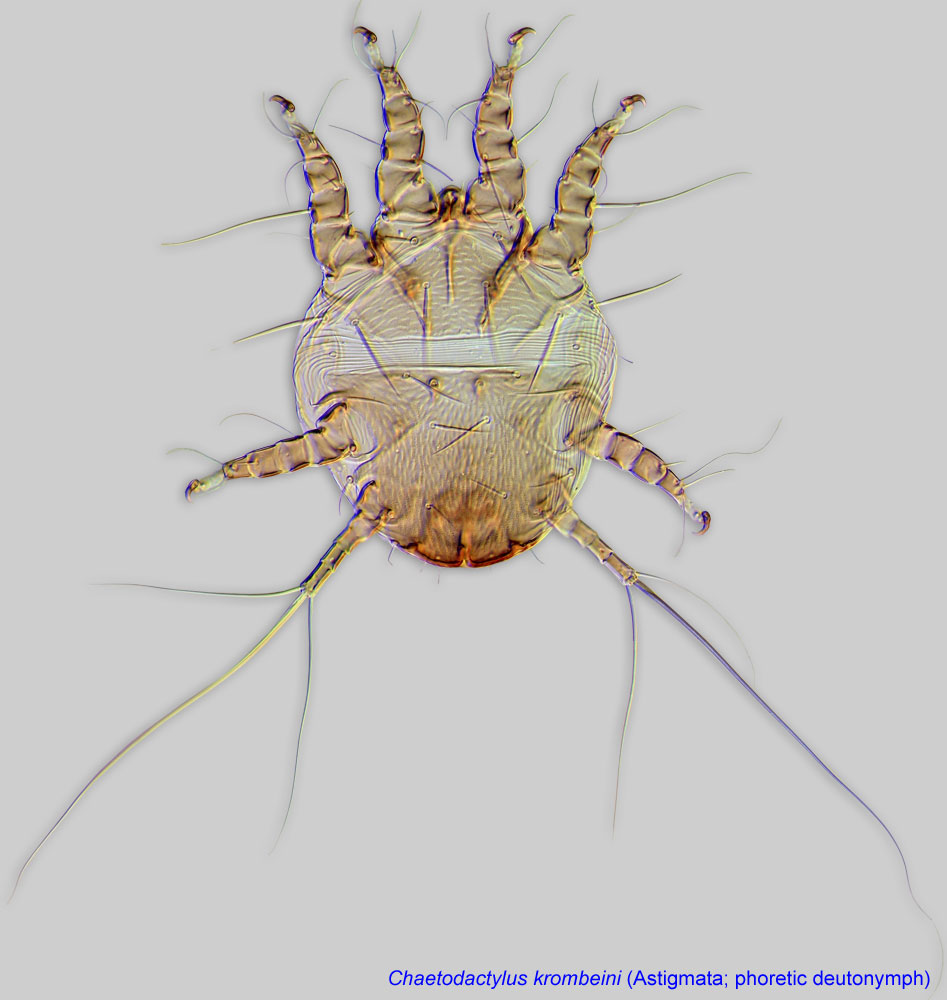 and adults are predatory and largely neutral as they feed on small invertebrates in nests
and adults are predatory and largely neutral as they feed on small invertebrates in nests
Leptus Latreille, 1796
Superorder Acariformes » Order Trombidiformes » Suborder Prostigmata » Infraorder Anystina » Hyporder Parasitengona » Family Erythraeidae » Genus Leptus
Acarus phalangii Gée. Fab" (=Acarus phalangii De Geer, 1778)
Larva: Prodorsalprodorsal:
Pertaining to the prodorsum.
region with 2 pairs of trichobothriatrichobothrium:
Modified seta that can be distinguished from true seta by its distinct large socket (complex cup-like cavity), and often, shape (which may be filiform, ciliate, pectinate, or thickened or clubbed). Present in many Acariformes (except Astigmata) and Opilioacarida (Parasitiformes). When paired and situated on the propodosoma, termed "prodorsal."
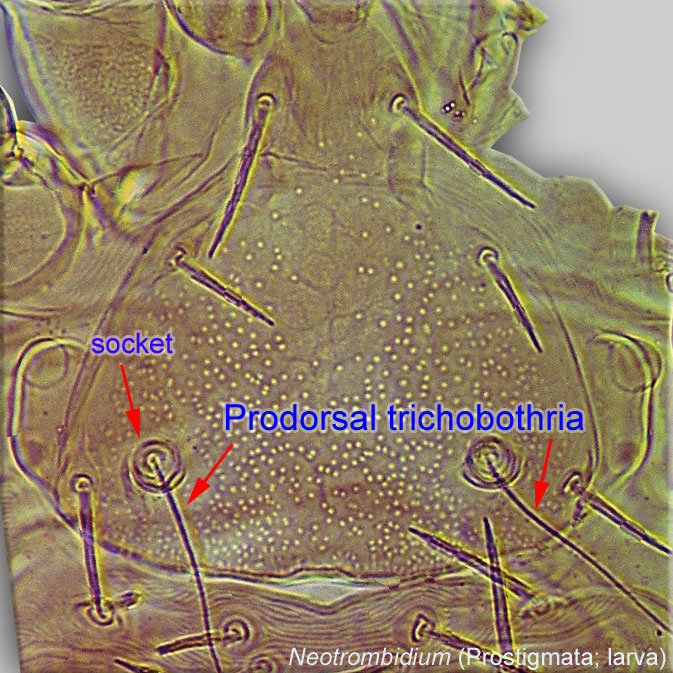 and 1 pair of eyes (Fig. 1). Cheliceral base flasklike in outline (dorsal aspect) (Fig. 1). Palpgenu and palpfemur with 1 seta each (Fig. 1). UrstigmataUrstigma:
and 1 pair of eyes (Fig. 1). Cheliceral base flasklike in outline (dorsal aspect) (Fig. 1). Palpgenu and palpfemur with 1 seta each (Fig. 1). UrstigmataUrstigma:
Paired, rounded area between coxae of legs I-II in Parasitengona larvae. Homologous to Claparède organ.
absent between coxal plates I-II (Fig. 2). Coxal plates I-II well-separated (Fig. 2), coxal plates II-III with 1 seta each (Fig. 2). Anus absent (Fig. 2). GenuaGenu:
Leg or palp segment (also known as podomere or palpomere) between tibia and femur.
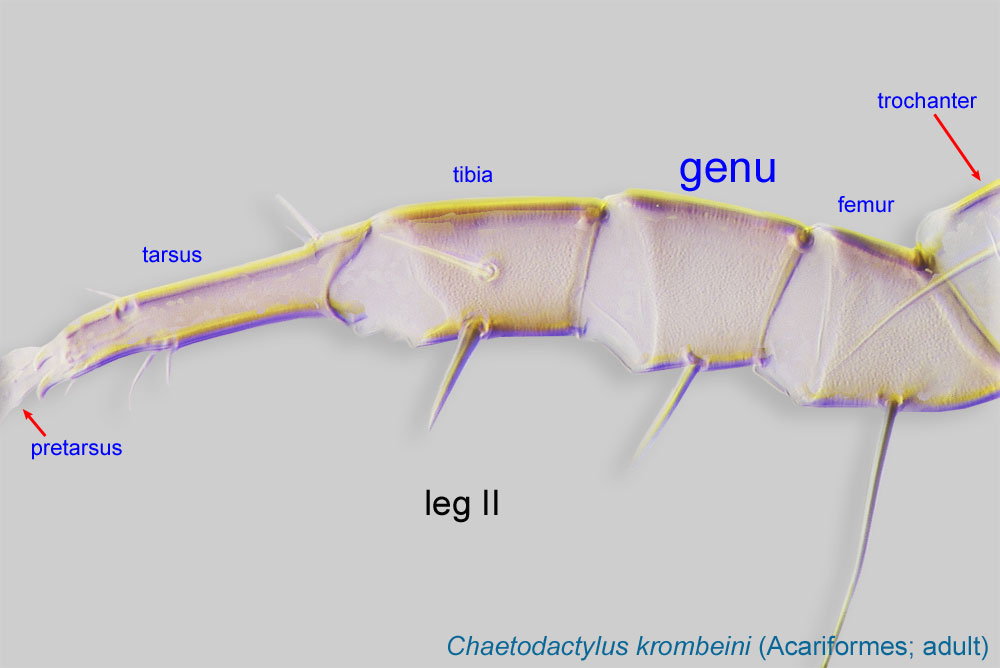 II, III with less than 11 barbed setae each (Fig. 2). No trichobothriatrichobothrium:
II, III with less than 11 barbed setae each (Fig. 2). No trichobothriatrichobothrium:
Modified seta that can be distinguished from true seta by its distinct large socket (complex cup-like cavity), and often, shape (which may be filiform, ciliate, pectinate, or thickened or clubbed). Present in many Acariformes (except Astigmata) and Opilioacarida (Parasitiformes). When paired and situated on the propodosoma, termed "prodorsal."
 on genugenu:
on genugenu:
Leg or palp segment (also known as podomere or palpomere) between tibia and femur.
 , tibiatibia:
, tibiatibia:
Leg or palp segment (also known as podomere or palpomere) between tarsus and genu.
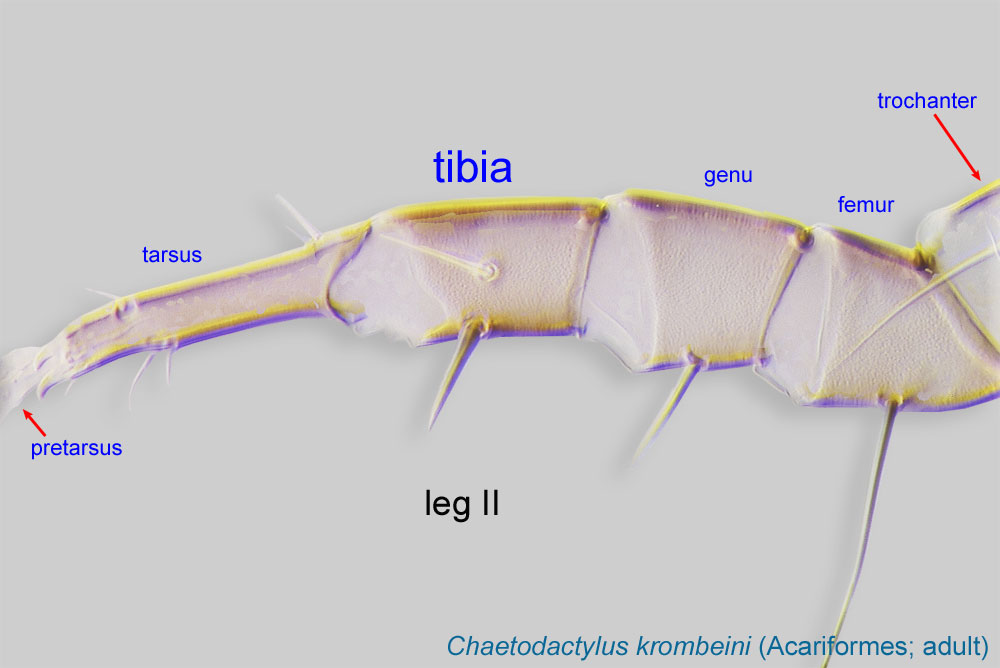 , and tarsustarsus:
, and tarsustarsus:
Terminal segment (also known as podomere or palpomere) of legs or palps. In Parasitoformes it can be subdivided into telotarsus and basitarsus.
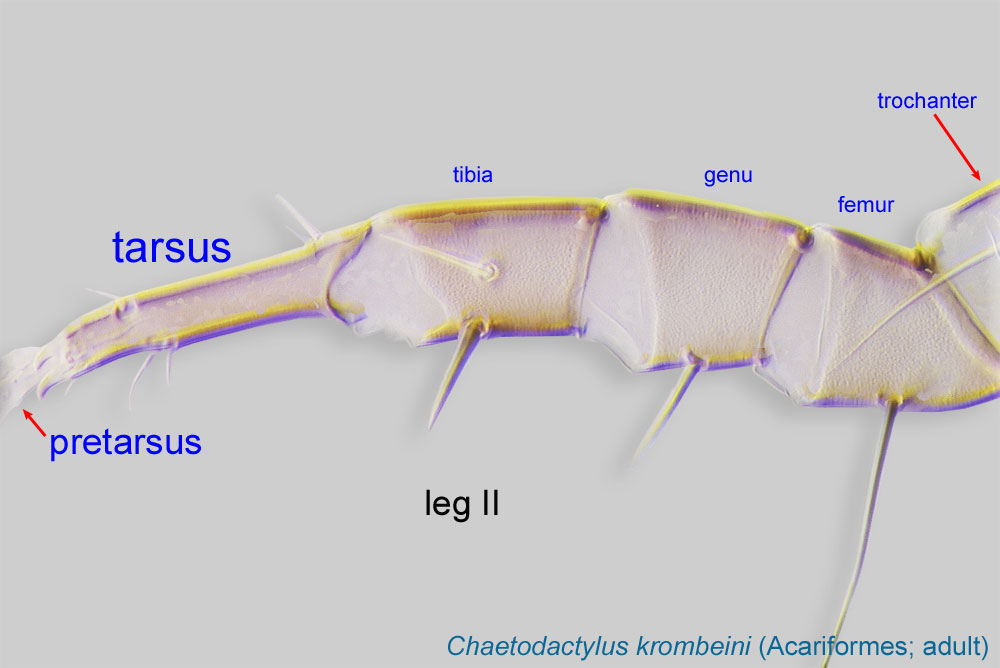 I (Fig. 1). Tibiatibia:
I (Fig. 1). Tibiatibia:
Leg or palp segment (also known as podomere or palpomere) between tarsus and genu.
 I with 2 solenidiasolenidion:
I with 2 solenidiasolenidion:
Thin-walled, terminally rounded or pointed filiform or peglike structure that is not birefringent in polarized light (unlike common setae in Acariformes). Often appears striated because of its internal structure. Found on the palpal tarsus on the gnathosoma and may also occur on the tarsus and tibia, less frequently on the genu, and occasionally on the femur of legs I-IV. In Acariformes, leg solenidia often arise from unsclerotized areas.
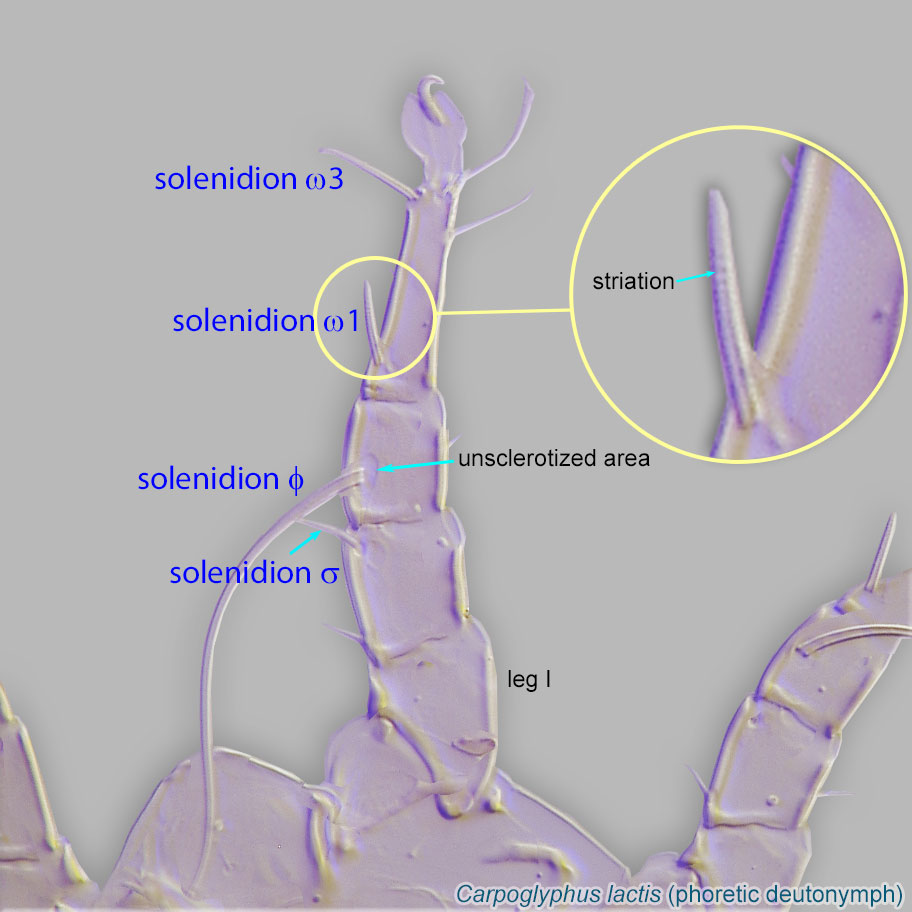 (Fig. 1).
(Fig. 1).
This is a species-rich genus with no key available for all species. The two described species attacking bees (Leptus ariel and L. monteithi) can be identified using Southcott, 1989Southcott, 1989:
Southcott, R. V. 1989. A larval mite (Acarina: Erythraeidae) parasitizing the European honey bee in Guatemala. Acarologia 30: 123-129. and Southcott, 1993Southcott, 1993:
Southcott, R. V. 1993. Larvae of Leptus (Acarina: Erythraeidae) ectoparasitic on higher insects of Australia and New Guinea. Invertebrate Taxonomy . 7 : 1473-1550..
Cosmopolitan. Species parasitizing bees have been found in the Nearctic, Neotropical, and Australian regions.
Bee hosts include the European honey bee (Apis mellifera) and a colletid, Leioproctus
temporarytemporary:
some life stages are associated with bees, while others are not
Mites belonging to the large and cosmopolitan genus Leptus are parasitic as larvae and use a wide range of arthropods to feed. Most common hosts are arachnids (commonly spiders and opiliones) and various orders of insects. Many species are not host specific, attacking an array of disparate hosts (including bees). Mite larvae pierce the cuticle of the host and ingest hemolymph and interstitial fluids via a stylostome, which acts as a proteinaceous drinking straw. After engorging, larvae drop off the host and transform into octopod nymphs and then adults. Both adults and deutonymphsdeutonymph:
Ontogenetic stage between protonymph and tritonymph (or adult, if tritonymph is absent). See <a href="index.cfm?pageID=1720">Life stages page</a> for more details. are free-living predators of small invertebrates.
are free-living predators of small invertebrates.
Only two described species are known to attack bees: Leptus ariel, from honey bee Apis mellifera in Guatemala, and Leptus monteithi, from the colletid bee Leioproctus sp. in Tasmania (Southcott, 1989Southcott, 1989:
Southcott, R. V. 1989. A larval mite (Acarina: Erythraeidae) parasitizing the European honey bee in Guatemala. Acarologia 30: 123-129.; Southcott, 1993Southcott, 1993:
Southcott, R. V. 1993. Larvae of Leptus (Acarina: Erythraeidae) ectoparasitic on higher insects of Australia and New Guinea. Invertebrate Taxonomy . 7 : 1473-1550.). In addition, several unidentified species have been recorded parasitizing European honey bees in the USA, Peru, Colombia, and Brazil (Fletchtmann, 1980Fletchtmann, 1980:
Fletchtmann, C. H. W. 1980. Dois acaros associados a abelha Apis mellifera L. no Peru. Anais da Escola Superior de Agricultura "Luiz de Queiroz" 37: 737-741.; Losada, 1947Losada, 1947:
Losada, B. S. 1947. Nuevas especies para Colombia: localizadas por primera vez por la sección de entomología. Revista Facultad Nacional de Agronomía, Medellín 7: 325-332.; Teixeira, 2011Teixeira, 2011:
Teixeira, E. W. 2011. Larvas de Leptus sp. Latreille 1796 (Acarina: Erythraeidae) em abelhas africanizadas A. mellifera Linnaeus 1758 (Hymenoptera: Apidae), no Brasil. Pesquisa amp; Tecnologia . 8 : no page numbers.; Wilson et al., 1990Wilson et al., 1990:
Wilson, W. T., W. L. Rubink amp; A. M. Collins. 1990. A larval species of erythraeid mite ( Leptus sp., Acarina: Erythraeidae) ectoparasitic on adult honey bees ( Apis mellifera L.) in south Texas. BeeScience . 1 : 18-22.; Wilson et al., 1987Wilson et al., 1987:
Wilson, W. T., T. A. Wooley, R. A. Nunamaker amp; W. L. Rubink. 1987. An erythraeid mite externally parasitic on honey bees ( Apis mellifera ). American Bee Journal . 127 : 853-854.)